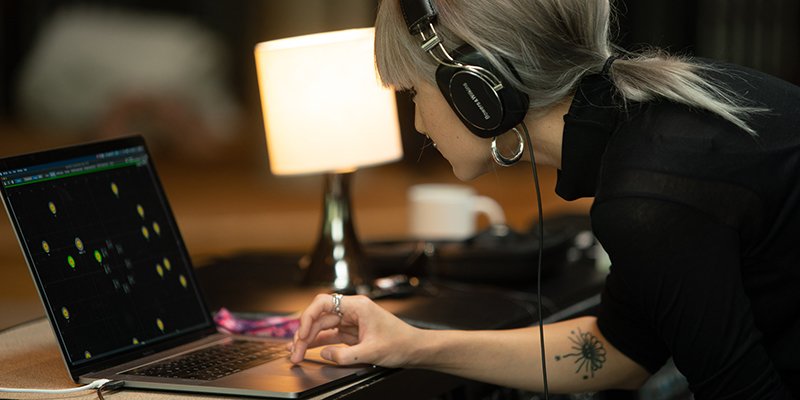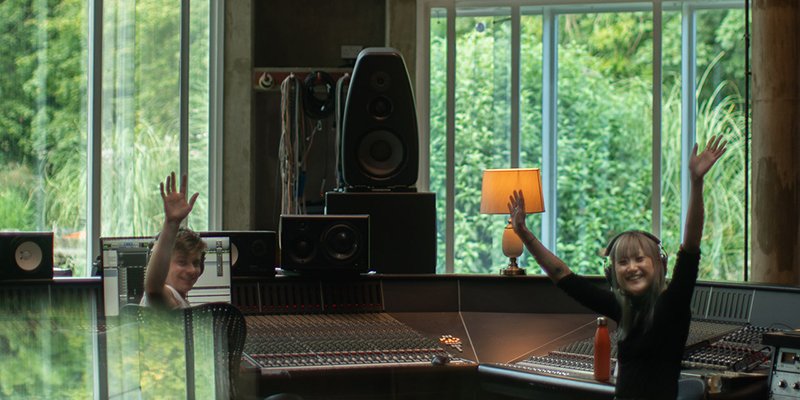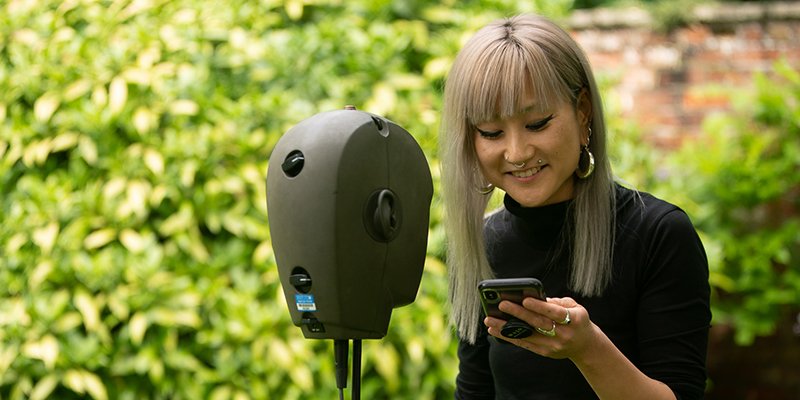Hinako Omori: Finding Stillness

Amidst the chaos of a world marked by seemingly permanent crisis, producer and composer Hinako Omori encourages us to tune back into the stillness of our natural surroundings. Although she was raised in London, Omori’s work is rooted in a respect for nature and tranquility that she ascribes more to her Japanese heritage. Merging the tradition of Shinrin-yoku, or forest bathing, with her musical practice, Omori uses field recordings to simulate the therapeutic experience of immersing oneself in nature – and illuminate the enduring connection between the inner self and the outside world.
Healing frequencies
“I think there are studies that show that if you look at a photo of nature, like forests, it really has a very positive effect on your wellbeing,” explains Omori. “And, so I wondered if the audio side would have a similar effect, even if you can’t be in that space.” She mentions health benefits like reducing heightened cortisol levels, sympathetic nerve activity and blood pressure – all common signs of acute or chronic stress.
Nature-led stress relief became especially important during the lockdowns of 2020. At that time, she remembers, “[the outdoors] was sometimes the only place we could go, like to the park. I feel like that must have really boosted all of our wellbeing, just being there, because it literally was the only place we could go.”
So, when she was invited to Peter Gabriel’s Real World Studios in the summer of 2020 for an immersive audio project with Womad Festival, she was inspired by the beauty of the studio’s surroundings and decided to incorporate them into her first album, a journey. “There’s a stream flowing around the studio and there are floor-to-ceiling windows so you can see out into the environment – it’s the most peaceful place I think I’ve ever been.”

Hinako Omori at Peter Gabriel’s Real World Studios, UK
The music itself was finished before she arrived at the studio, and she went with a clear concept already in place for how she’d spend her time there. She wanted to craft an auditory space where listeners, regardless of their location, could put on a pair of headphones and be instantly transported into the natural world. “The music existed as one piece already. But I wanted to make an environment where you can flow in and out of different spaces.”
Capturing nature
Prior to the studio visit, Omori researched the area to find the types of natural sounds she wanted to capture. She was especially interested in the rustling of leaves in the wind and the cleansing qualities of water, and she made a point of scheduling a visit to the Chew Valley Lake to record aquatic movement for the song “Ocean.”
On the day, she and the studio’s head engineer Katie May drove to the nearby Mendip Hills, equipped with a Neumann KU100 binaural microphone, which is shaped like a human head and designed to record 3D audio. “It allowed us to capture sound that really felt like you were in the space, rather than just a stereo recording,” she explains. “It was a phenomenal, massive recording.”
But, even with a lot of pre-planning and research of the area, the art of field recording is typically dependent on the natural offerings of the moment. “It’s nature,” she says, “and you can’t predict what’s going to come out, what you can record.” It requires a lot of patience to capture the essence of a scene over time.

Hinako Omori making field recordings with a Neumann KU100 binaural microphone
Intuitive composing
“It would have probably been a very different record had it not been for the invitation [from Real World],” she admits. There were only a couple of weeks from when she accepted until the studio date, so she had to assemble the music quickly to be ready in time for the session. Luckily, Omori’s approach to composition is rather intuitive – she gathers and assembles sounds, rearranging and experimenting with them until they coalesce into a harmonious work, much like a collage.
“It kind of mapped itself out. I started piecing together the melodies and keys, and found that the next one was starting in that same key. It’s almost like the music was telling me which order to put them in. So I kind of just went with it.”
She employed the same approach when it came time to mix the record and weave in the field recordings. Other than the deliberately sought-out water sounds for “Ocean,” most of the audio she picked up was recorded instinctively, and then allowed to fit organically around the existing work, “rather than specifying ‘oh I definitely want this sound here,’” she says. “Weirdly, it didn’t feel forced… And I didn’t want to change the sounds of nature in any way because it is a map of where we were. And so none of it’s [produced with] effects, there’s no processing on it. I just wanted to make it as it is.”
Storytelling
It might not be surprising that an artist with such a connection to the natural environment feels compelled to preserve it, too. “With music,” she explains, “I feel like we have a really unique opportunity to directly connect with people’s feelings.” So, for a project with the BBC, she reimagined Vaughan Williams’ best-known work, “The Lark Ascending,” in an electronic arrangement to highlight the UK’s declining population of the bird. “I got the score of Vaughan Williams sent over from the archives and was lucky enough to have the space to experiment with that and create something new.”
She was careful to stay faithful to the original score out of respect for the composer. The innovative part of the project came from her choice of instrumentation – she used the field recordings of the lark’s song to recreate the original violin melody, which required a lot of careful, detailed editing of the recordings. She was surprised by the variety that appeared from a recording that initially sounded like a series of simple tones. “Every millisecond has an inflection or a melody or something. You think it’s one note and then you actually dive in and discover there’s probably 50 notes in here. So that was a joy to sit with.”
Her contributions to Brian Eno’s charity project, Earth/Percent, were created with a similar goal in mind. The organization encourages artists to pledge a small percentage of their income to be distributed between a variety of climate interventions, including energy transition, climate conservation, climate justice and policy change. Omori contributed works to the organization’s two most recent Earth Day compilations – first in 2022, with a vocal interpretation of Michio Miyagi’s “Haru no umi” [“The Sea in Spring”], which was composed for the Japanese instruments koto and shakuhachi in 1929.
To honor the theme of the piece, she included hydrophone recordings of the sea near her grandmother’s house in Zushi, Japan. “I felt it was a snapshot of a beach, and that meant a lot to me, especially as a kid. And also ties in with the fact that Miyagi was using his childhood image of the sea where he grew up as well. So I think there were a lot of factors that just felt like that piece in particular resonated with what Earth/Percent was.”
Listening inward
Omori was also at her grandmother’s house in Japan when she recorded her second LP, stillness, softness, which was released in October 2023. Sonically, it’s a noticeable departure from her first album. This time, she was more comfortable altering field recordings she took on a train, to give an off-kilter feel to the sounds. The record also features her voice more prominently, which she says she didn’t anticipate, exactly. “It just seemed to happen. I never really thought of having a lead vocal per se, because even in the last album it was more of a texture rather than a vocal.”
The difference in sound presents a variation on the themes of her earlier work. She relays a friend’s comment on the main difference between the albums: “She said that a journey is like listening to what’s around you. And with this new album it’s listening to what’s within you. I didn’t really think about it like that before, but it is kind of true.”
Healing, says Omori, whether for an individual or for a society, should be approached with love. She acknowledges the anger and hurt that many people feel when they witness the loss of our natural environment. “But if we approach things through a lens of love, understanding, communicating, and connecting with nature and our surroundings and why it’s important to look after them from that emotional place, I feel like that can be the most powerful way to approach climate change.”
To artists who want to contribute to the climate movement, she advises, “Listen inward to what resonates with you. I think anything that we create from an authentic place will resonate with people that listen to it. So I think trust, listen inward and see what arises.”
This interview is the first in a series of collaborative articles that explore the relationship between music-making and environmentalism, made together with Magnetic Magazine.
Read their version of the article ›
Keep up with Hinako Omori on Instagram and Bandcamp and her website
Real World Studios photos by York Tillyer